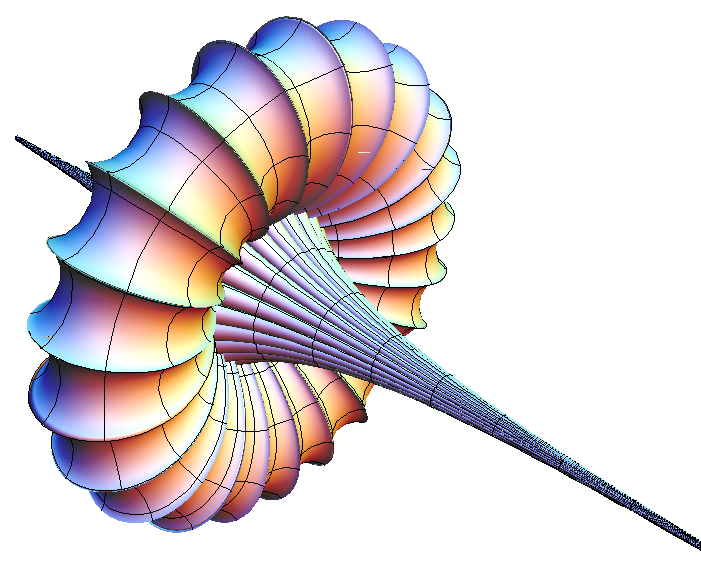Breather Surface

Parametric Breather Surface Parametric Equations:
r := 1 - b^2; w := Sqrt[r]; denom := b*((w*Cosh[b*u])^2 + (b*Sin[w*v])^2) breather = {-u + (2*r*Cosh[b*u]*Sinh[b*u])/ denom, (2*w*Cosh[b*u]*(-(w*Cos[v]*Cos[w*v]) - Sin[v]*Sin[w*v]))/ denom, (2*w*Cosh[b*u]*(-(w*Sin[v]*Cos[w*v]) + Cos[v]*Sin[w*v]))/denom} ParametricPlot3D[ Evaluate[breather /. b -> 0.4], {u, -13.2, 13.2}, {v, -37.4, 37.4}, PlotRange -> All, PlotPoints -> {60, 150}]
u controls how far the tip goes. v controls the girth. b varies from 0 to 1
The above image has boundary {u,-13.2,13.2} and {v,-37.4,37.4}, with b=0.4.
See also Breather surface
There's some request to see this surface breathing.
I asked Richard Palais, he gave me some explanation. Here's from what i understand.
There's this PDE
D[f[x,t],{t,t}] - D[f[x,t],{x,x}] + Sin[f[x,t]] == 0
This is called the Sine-Gordon equation
It turns out, solutions to this equation corresponds to unique pseudo-spherical surfaces. (the function represents the surface in Asymptotic coordinates). i.e. there's a one-to-one map from solutions of sine-Gordon and pseudo-spherical surfaces.
But also, solution to sine-Gordon are of interest to physicists in what's called Soliton. Typically, a solution f[x,t] is plotted as a animation, with t fixed, giving a function of one var x. And with t varies, creates a animation. (t is considered as time) This animation is called a breather, because it looks like a wave that breaths. (you can see this animation in Mac version of 3dxm, under the Wave category).
But since f[x,t] can also be plotted as a parametric surface (a pseudosphere), but since it's a static image, so it doesn't breath.
So the breather surface doesn't really breath. The name is borrowed due to this pseudosphere's formula being a correspondence to a non-linear wave called Breather
There's the question of wheat her there's some kinda visual correspondence between the function f plotted as a 2D animation and plotted as a surface… i don't know.
References:
A Modern Course on Curves and Surfaces , by Richard S Palais. page 108. curves_surfaces_palais.pdf
Lecture notes on curves and surfaces in R3 , by Chuu-Lian Terng. page 60. Surfaces_in_R3.pdf
About Pseudospherical Surfaces (1990s), by Chuu-Lian Terng. Pseudospherical_Surfaces.pdf